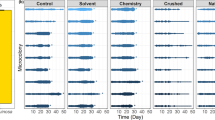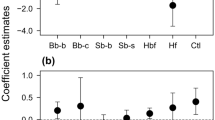Abstract
We investigated the effect of petal-size variation in tall bellflower, Campanula americana, on pollen removal rates, seed set, and pollinator behavior. Pollen removal, seed set, and the behavior of two bee visitors (Bombus and Halictus) were assessed in flowers that had 0%, 50%, or 100% of their petal lobes removed. Pollen removal rates did not differ significantly among the three treatment groups, probably due to the presence of an ineffective (“ugly”) pollinator (Halictus), which quickly removed pollen from completely reduced flowers. Seed set was significantly positively correlated with petal size. Bumblebees discriminated against reduced flowers, thereby lowering pollen movement to reduced flowers. Halictid bees rarely contacted stigmatic surfaces and thus pollen delivery to reduced flowers was limited. The presence of an ugly pollinator probably obscured the effect of petal reduction on pollen receipt, thus masking the impact of attractive structures on male fitness. Given the positive relationship between seed set and petal size, we caution against ascribing expenditure on attractive structures exclusively to male function. In plants with many olules, expenditure on attractive structures may affect seed set.
Similar content being viewed by others
References
Bell G (1985) On the function of flowers. Proc Roy Soc Lond B 224: 223–265
Campbell DR (1989a) Measurements of selection in a hermaphroditic plant: variation in male and female pollination success. Evolution 43: 318–334
Campbell DR (1989b) Inflorescence size: test of the male function hypothesis. Am J Bot 76: 730–738
Charlesworth D, Charlesworth B (1987) The effect of investment in attractive structures on allocation to male and female functions in plants. Evolution 41: 948–968
Charlesworth D, Schemske DW, Sork VL (1987) The evolution of plant reproduction characters: sexual selection versus natural selection. In: Stearns SC (ed) The evolution of sex and its consequences. Birkhäuser, Basel, pp 317–335
Charnov EL, Bull JJ (1986) Sex allocation, pollinator attraction and fruit dispersal in cosexual plants. J Theor Biol 118: 321–326
Cresswell J E, Galen C (1991) Frequency-dependent selection and adaptive surfaces for floral character combinations: the pollination of Polemonium viscosum. Am Nat 138: 1342–1353
Cruden RW, Lyon DL (1975) Patterns of biomass allocation to male and female functions in plants with different mating systems. Oecologia 66: 299–306
Cruzan MB, Neal PR, Willson MF (1988) Floral display in Phyla incisa: consequences for male and female reproductive success. Evolution 42: 505–515
Day RW, Quinn GP (1989) Comparison of treatments after an analysis of variance in ecology. Ecol Monogr 59: 433–463
Delph LF (1994) Flower size dimorphism in plants with unisexual flowers. In: Lloyd DG, Barrett SCH (eds) Floral biology. Chapman and Hall, New York (in press)
Delph LF, Lively CM (1992) Pollinator visitation, floral display, and nectar production of the sexual morphs of a gynodioecious shrub. Oecologia 63: 161–170
Eckhart VM (1991) The effects of floral display on pollinator visitation vary among populations of Phacelia linearis (Hydrophyllaceae). Evol Ecol 5: 370–384
Galen C (1985) Regulation of seed-set in Polemonium viscosum: floral scents, pollination and resources. Ecology 66: 792–797
Galen C (1989) Measuring pollinator-mediated selection on morphometric floral traits: bumblebees and the alpine sky pilot, Polemonium viscosum. Evolution 43: 882–890
Galen C, Plowright RC (1985) The effects of nectar level and flower development on pollen carry-over in inflorescences of fireweed (Epilobium angustifolium) (Onagraceae). Can J Bot 63: 488–491
Harder LD, Thomson JD, Cruzan MB, Unnasch RS (1985) Sexual reproduction and variation in floral morphology in an ephemeral lily, Erythronium americanum. Oecologia 67: 286–291
Lloyd DG (1988) Benefits and cost of biparental and uniparental reproduction in plants. In: Michod RE, Levin BR (eds) The evolution of sex. Sinauer, Sunderland, Mass, pp 233–252
Lovett Doust J, Cavers PB (1982) Biomass allocation in hermaphroditic flowers. Can J Bot 60: 2530–2534
Mitchell TB (1960) Bees of the eastern United States, vol 1. North Carolina Agricultural Experiment Station, Raleigh, NC
Pleasants JM, Chaplin SJ (1983) Nectar production rates of Asclepias quadrifolia: causes and consequences of individual variation. Oecologia 59: 232–238
Plowright RC (1981) Nectar production in the boreal forest lily, Clintonia borealis. Can J Bot 59: 156–160
Queller DC (1985) Sexual selection in a hermaphroditic plant. Nature 305: 706–707
Richardson TE, Stephenson AG (1989) Pollen removal and pollen deposition affect the duration of the staminate and pistillate phases in Campanula rapunculoides. Am J Bot 76: 532–538
Richardson TE, Stephenson AG (1991) Effects of parentage, prior fruit set and pollen load on fruit and seed production in Campanula americana L. Oecologia 87: 80–85
Shetler SG (1979) Pollen-collecting hairs of Campanula (Campanulaceae). I. Historical review. Taxon 28: 205–215
Stanton ML, Preston RE (1988a) Ecological consequences and phenotypic correlates of petal size variation in wild radish, Raphanus sativus (Brassicaceae). Am J Bot 75: 528–539
Stanton ML, Preston RE (1988b) A qualitative model for evaluating the effects of flower attractiveness on male and female fitness in plants. Am J Bot 75: 540–544
Stanton ML, Young HJ, Ellstrand NC, Clegg J (1991) Consequences of floral variation for male and female reproduction in experimental populations of wild radish, Raphanus sativus L. Evolution 45: 268–280
Thomson JD, Thomson BA (1992) Pollen presentation and viability schedules in animal-pollinated plants: consequences for reproductive success. In: Wyatt R (ed) Ecology and evolution of plant reproduction. Chapman and Hall, New York, pp 1–25
Willson MF, Price PW (1977) The evolution of inflorescence size in Asclepias (Asclepiadaceae). Evolution 31: 495–511
Wilson P, Thomson JD (1991) Heterogeneity among floral visitors leads to discordance between removal and deposition of pollen. Ecology 72: 1503–1507
Wilson P, Thomson JD, Stanton ML, Rigney LP (1994) Beyond floral Batemania: gender biases in selection for pollination success. Am Nat 143: 283–296
Author information
Authors and Affiliations
Corresponding author
Rights and permissions
About this article
Cite this article
Johnson, S.G., Delph, L.F. & Elderkin, C.L. The effect of petal-size manipulation on pollen removal, seed set, and insect-visitor behavior in Campanula americana . Oecologia 102, 174–179 (1995). https://doi.org/10.1007/BF00333249
Received:
Accepted:
Issue Date:
DOI: https://doi.org/10.1007/BF00333249




